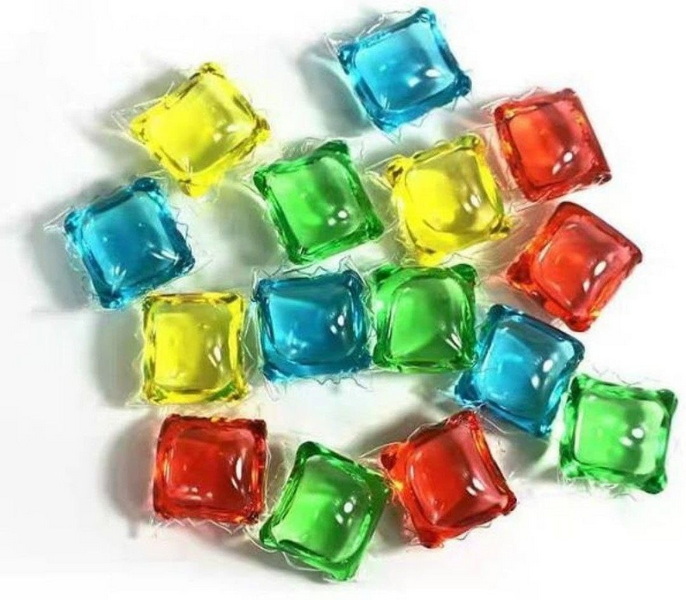Dongguan UFine Daily Chemical Co.,Ltd.
- All
- Product Name
- Product Keyword
- Product Model
- Product Summary
- Product Description
- Multi Field Search
Views: 222 Author: Tomorrow Publish Time: 10-27-2025 Origin: Site











Content Menu
● Choosing the Right Laundry Pods
● Gathering Your Laundry Supplies
● Selecting the Right Wash Cycle
● Folding and Putting Away Clothes
● Tips for Saving Time and Money
● Eco-Friendly Laundry Practices
● Troubleshooting Common Issues
● Staying Consistent with Laundry Habits
● FAQ
>> 1. How many laundry pods should I use per load?
>> 2. Can I use laundry pods in cold water?
>> 3. Should I put the laundry pod in before or after the clothes?
>> 4. Are laundry pods safe for high-efficiency (HE) machines?
>> 5. What should I do if the laundry pod doesn't dissolve?
College life brings newfound independence, and with it comes the responsibility of managing everyday tasks like laundry. For many students, using laundry pods is the most convenient and efficient way to keep clothes clean without the hassle of measuring detergent or dealing with spills. This guide walks through everything you need to know about doing laundry in college using pods—from choosing the right type to avoiding common mistakes.

Not all laundry pods are created equal, especially when it comes to the unique demands of college living. Students often deal with limited space, shared laundry facilities, and a wide variety of fabrics—from dorm room sheets to workout clothes. Selecting the right laundry pod can make a big difference in both cleaning performance and convenience.
Look for pods that are compact and pre-measured, eliminating the need for bulky detergent bottles. Many top brands offer pods designed specifically for high-efficiency (HE) machines, which are commonly found in dorms and apartment complexes. Using non-HE detergent in these machines can lead to excess suds and poor rinsing, so always check the packaging.
Scent is another consideration. Some students prefer fragrance-free options, especially if they have sensitive skin or share laundry rooms with others who may be affected by strong perfumes. Others enjoy long-lasting scents that keep clothes smelling fresh between wears. Pods with added fabric softeners or stain fighters can also be beneficial for tackling tough odors from gym clothes or spills.
Additionally, consider travel-friendly packaging. Resealable pouches or compact boxes are easier to store in small dorm closets and transport between home and campus.
Before starting your first load, make sure you have all the essentials. While laundry pods simplify the detergent portion, you'll still need a few other items to ensure a smooth process.
Start with a durable laundry basket or collapsible bag to carry your clothes to and from the laundry room. Mesh laundry bags are useful for delicates like underwear or bras, helping to prevent damage during the wash cycle. If you plan to dry your clothes, dryer sheets or wool dryer balls can reduce static and soften fabrics naturally.
Don't forget a pair of gloves if you're handling heavily soiled clothes, and keep a stain remover pen or spray on hand for treating spots before washing. A small laundry bag with compartments can help organize your supplies and make transport easier.
Having a laundry schedule or reminder system can also help you stay on track. Many college students benefit from doing a small load once a week rather than waiting for a massive pile to accumulate.
Sorting is a crucial step that many students overlook. Washing everything together might seem efficient, but it can lead to color bleeding, fabric damage, and ineffective cleaning.
Separate your clothes into three main categories: whites, darks, and colors. This prevents dyes from transferring and keeps whites looking bright. Always check garment labels for washing instructions—some items may require cold water or a gentle cycle.
Delicates, such as lingerie or silk items, should be washed separately or in a mesh bag. Heavily soiled items like workout clothes or towels may need a longer wash cycle or an extra rinse.
If you're short on time, consider using color-catching sheets in mixed loads to reduce the risk of dye transfer. However, these are not a substitute for proper sorting and should be used cautiously.
Most college laundry facilities use shared front-loading or top-loading machines. These are typically coin-operated or require a campus card swipe. Before loading, make sure the machine is clean and free of leftover detergent or lint.
Never overload the machine. A good rule of thumb is to fill it about three-quarters full, leaving enough space for clothes to move freely during the cycle. Overloading reduces cleaning efficiency and can strain the machine.
Place the laundry pod directly into the drum of the washer before adding clothes. This ensures the pod dissolves properly and distributes detergent evenly. Never put the pod in the detergent dispenser drawer, as it may not dissolve correctly and could leave residue.
If you're washing a large or heavily soiled load, some manufacturers recommend using two pods. However, always follow the instructions on the packaging to avoid overuse, which can leave residue or cause excess suds.
Choosing the appropriate cycle is key to getting clean clothes without damage. Most college machines offer basic settings: cold, warm, or hot water, and cycles like normal, permanent press, or delicate.
Cold water is ideal for darks and colors, helping to preserve fabric and prevent shrinking. It's also more energy-efficient, which is better for the environment and often required in shared facilities.
Warm water works well for whites and heavily soiled items, while hot water should be reserved for towels, bedding, and sanitizing needs. However, hot water can shrink certain fabrics and fade colors, so use it sparingly.
The normal cycle is suitable for everyday clothing like jeans and t-shirts. Use the permanent press cycle for dress shirts or synthetic fabrics to reduce wrinkles. Delicates should be washed on the gentle cycle to avoid damage.
Always check if your machine has a high-efficiency (HE) setting and use HE-compatible pods accordingly.
Once the wash cycle is complete, transfer your clothes to the dryer promptly to prevent mildew and musty odors. Overloading the dryer can lead to uneven drying and increased wrinkles, so leave space for air circulation.
If using dryer sheets, add one per load to reduce static and add a light fragrance. Wool dryer balls are a reusable alternative that can soften clothes and reduce drying time.
Check garment labels for drying instructions. Some items, like athletic wear or spandex, should be air-dried to maintain elasticity and shape. Cotton towels and jeans can typically handle high heat, but lower settings are gentler on fabrics and save energy.
If you don't have access to a dryer, hang clothes in your room or a designated drying area. Use a foldable drying rack to save space and ensure good airflow.

After drying, fold or hang your clothes immediately to minimize wrinkles. Invest in a few hangers for dress clothes or shirts that tend to crease.
Use drawer dividers or storage bins to keep your closet organized. Group similar items together—socks, underwear, t-shirts—to make getting dressed easier during busy weeks.
If you live in a dorm, consider using under-bed storage containers for seasonal items or extra linens.
Even with the simplicity of laundry pods, students often make avoidable errors. One of the most common is using too many pods. One pod is usually enough for a standard load—using more doesn't mean cleaner clothes and can leave residue.
Another mistake is washing incompatible fabrics together. Always separate delicates and avoid mixing lint-producing items like towels with lint-attracting clothes like dark dress shirts.
Forgetting to empty pockets can lead to damaged clothes or clogged machines. Pens, tissues, or coins can cause stains or mechanical issues.
Some students also delay removing clothes from the washer or dryer, leading to wrinkles or mildew. Set a phone reminder if necessary.
Lastly, never leave personal items unattended in shared laundry rooms. Theft of detergent, laundry, or even machines is not uncommon.
Laundry doesn't have to be a time-consuming chore. Doing small loads regularly prevents last-minute rushes and makes the process more manageable.
Wash full loads when possible to maximize efficiency, but avoid overloading. If you're in a hurry, use the quick-wash cycle for lightly soiled clothes.
Many campuses offer laundry apps that notify you when machines are free or when your cycle is done. These can save time and reduce trips to the laundry room.
Buying laundry pods in bulk can lower the cost per load. Look for student discounts, campus deals, or multi-pack options online.
If your school has a laundry service, compare the cost with doing it yourself. For busy semesters, it might be worth the convenience.
Sustainability matters, even in college. Using cold water, full loads, and energy-efficient machines reduces your environmental impact.
Choose laundry pods with minimal packaging or recyclable materials. Some brands now offer water-soluble film and reduced plastic waste.
Avoid over-drying clothes—use the moisture sensor setting if available, or remove items while slightly damp and air-dry the rest of the way.
Line drying, when possible, saves energy and extends the life of your clothes.
Sometimes things go wrong. If your clothes come out with residue, it could be due to using too many pods, overloading the machine, or not using enough water. Try using one pod, reducing load size, or selecting a longer cycle.
If clothes still smell after washing, they may not be getting hot enough or are being left too long in the washer. Use a higher temperature setting or add a cup of white vinegar to the rinse cycle (though never mix vinegar with bleach).
Stains that remain after washing should be treated before rewashing. A stain remover pen or a paste of baking soda and water can help lift tough spots.
If the pod doesn't dissolve, ensure it's placed in the drum, not the dispenser, and that you're using enough water. Cold water can slow dissolution, so consider a longer cycle if needed.
Building a routine makes laundry less overwhelming. Pick a consistent day each week—like Sunday afternoon—to do your wash. Treat it like any other appointment.
Involve roommates or friends to make it social. You can share tips, split costs on supplies, or help each other fold.
Keep a small supply of pods in your room so you're never caught off guard. A spare laundry bag and a stain pen can also be lifesavers.
Doing laundry in college doesn't have to be stressful. With the convenience of laundry pods, the process becomes simpler, faster, and more reliable. By choosing the right products, sorting correctly, and following best practices, students can maintain clean, fresh clothes throughout the semester. Developing good habits early not only saves time and money but also promotes independence and responsibility—key skills for life beyond college.

Use one laundry pod for a standard-sized load. For extra-large or heavily soiled loads, check the manufacturer's instructions—some recommend using two pods. Never exceed the recommended amount, as this can lead to residue and poor rinsing.
Yes, most modern laundry pods are designed to dissolve in cold water. However, dissolution may be slower. To ensure complete breakdown, avoid overloading the machine and consider using a longer wash cycle.
Always place the laundry pod directly into the drum of the washing machine before adding clothes. This allows it to dissolve properly. Never place it in the detergent dispenser drawer, as it may not dissolve correctly.
Yes, but only if they are labeled as HE-compatible. Many brands offer HE-specific pods that produce fewer suds and work efficiently in low-water conditions. Always check the packaging before use.
If the pod remains intact, it may be due to overloading, cold water, or incorrect placement. Ensure the pod is in the drum, not the dispenser, and reduce the load size. Run the cycle again with warm water if necessary.